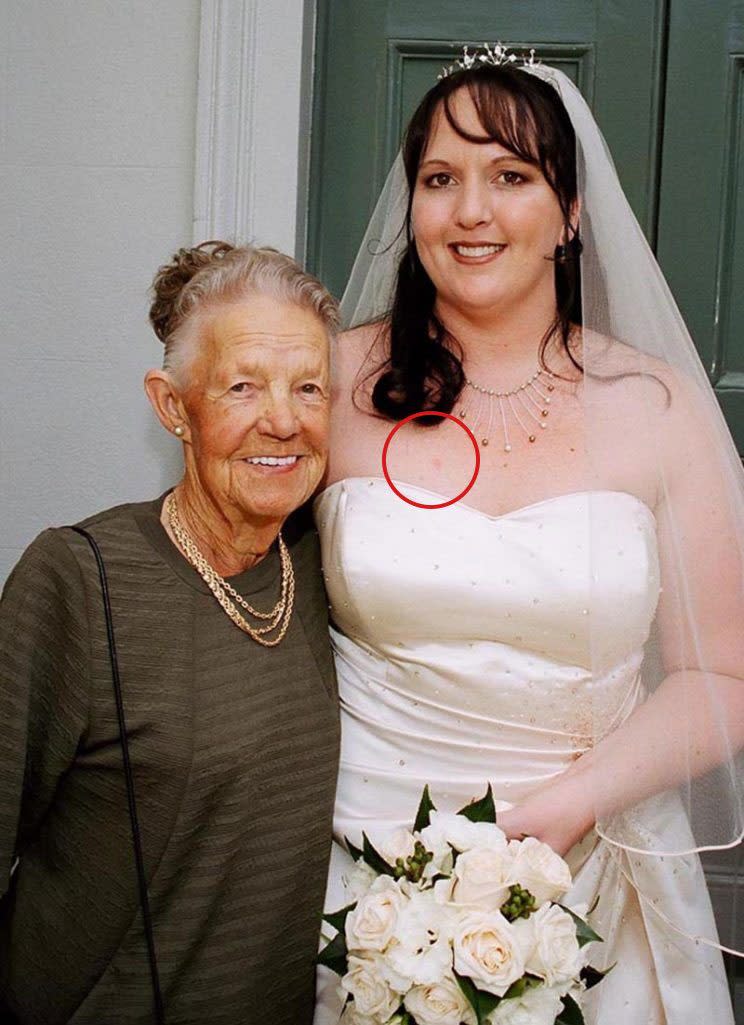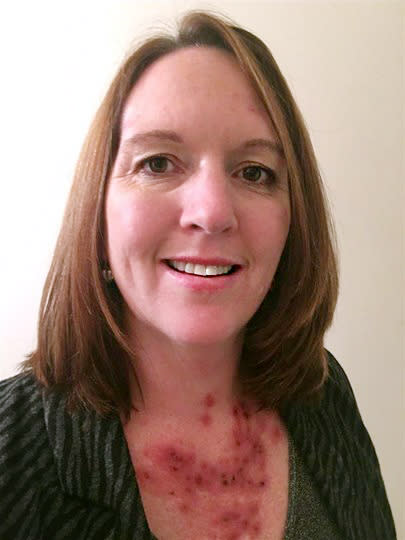Bride’s Wedding Photo Revealed Early Warning of Skin Cancer

Deborah Crofts wasn’t going to let a blemish on her chest spoil her wedding day. In a photo taken for her marriage in February 2007, a spot can clearly be seen peeking out above the neckline of her strapless, ivory gown. Sure, many brides are going to notice imperfections when they’re getting dressed and primped, but, according to the New Zealand Herald, “with all the excitement of her big day, she soon forgot about it.”
What she dismissed as a pimple was actually the first symptom of skin cancer.

The spot continued to cause problems for Crofts in the years that followed, according to the publication. It would continuously bleed in the shower, then scab over, in a “never-ending cycle.” Although it didn’t grow in size during this time, it would never heal, and it refused to go away, the 41-year-old mom told the New Zealand Herald.
Crofts didn’t know it then, but according to the American Cancer Society, one of the hallmark symptoms of basal cell carcinoma (BCC) — is “open sores (which may have oozing or crusted areas) that don’t heal, or that heal and then come back.”
Men Have Eating Disorders Too, and Zayn Malik is Proof
A year later, Crofts wisely decided to have a doctor examine it — and, as you might have guessed, she was diagnosed with BCC. According to the Skin Cancer Foundation, this is the most frequently occurring form of skin cancer. When Crofts was presented with the diagnosis, she admits she was “shocked and frightened.” She told told the publication, “I didn’t like the word ‘cancer’ — it was scary.” But her anxiety was somewhat allayed when doctors told her she could have the cancerous cells surgically removed and would not require chemotherapy treatment, according to the New Zealand Herald.

Crofts had the spot surgically removed while under a local anesthetic — and while wide awake. She was left with a “massive” scar on her chest, and has since had other areas treated, on her forehead, back, and chest, according to the publication.
According to Crofts, it was Facebook’s relatively new Timehop feature that gave her the rude awakening that her skin cancer had been present since at least 2007. The feature finds “throwback” photos and prompts the user to post them again — but in Crofts’ case, it prompted her to realize that the little annoying pimple that had plagued her wedding day was actually something much more serious.
Now, Crofts is alert to early warning signs of skin cancer and less shaken when she notices suspect spots. “Now I’ve had so many reoccurrences I just think: Not another one,” she told the New Zealand Herald. But she also knows to get treatment right away.

A Woman Says She Was Fired Over Her Breast Cancer Diagnosis
The Skin Cancer Foundation notes that more than 4 million cases of BCC are diagnosed in the United States annually, and that it rarely metastasizes beyond its original site. That said, a suspicious mole — especially one that has not healed for about two weeks — should not be taken in stride. “It can be disfiguring if not treated promptly,” the foundation’s site says.
Crofts’ post-op treatment, aside from having the cancerous lesions removed, has consisted of applying topical cream. But it’s not just a healing cream: It also “reacts with your skin if it detects cancerous cells, and treats it like an infection,” the New Zealand Herald reported. What the cream revealed for Crofts was “a big patch of the skin on my neck came out in a red angry rash, and what it highlighted was that I had a whole load of cancerous cells at a microscopic level.”

The New Zealand mother tells the publication that seeing the hidden, malignant cells materialize as a visible rash is even scarier than surgery itself. She adds, “I didn’t like the thought that the cream was on my skin when my son was cuddling me, but I checked with the doctor, and it was safe.”
So what caused Crofts’ BCC? She told the publication that she believes it was too much UV exposure while growing up in sunny New Zealand. The Skin Cancer Foundation confirms that “both long-term sun exposure over your lifetime and occasional extended, intense exposure (typically leading to sunburn) combine to cause damage that can lead to BCC.” The foundation concludes that while the fair-skinned, red- and blond-haired, and light-eyed among us are more susceptible, “anyone with a history of sun exposure can develop BCC.”
Luckily, Crofts doesn’t need any more treatment for the time being. She is cautious when out in the sun, using sunblock and wearing hats, sunglasses, and clothes that cover her shoulders. She’s also vigilant about protecting her children from exposure. “I nearly cried when my son didn’t have a hat and sun cream at school on an unexpected sunny day last year,” she told the New Zealand Herald.
Her story is a reminder that we should all take care. According to the Skin Cancer Foundation, “Men with BCC have outnumbered women with the disease, but more women are getting BCCs than in the past.” Crofts, who says she has never been much of sunbather, urges both men and women who worship the sun’s rays to rethink their habits. She tells the New Zealand Herald, “No amount of tanning is worth the stress of healing cancerous skin cells.”
If you think you might have a malignant mole or want to learn more about protecting yourself from skin cancer, please visit the websites of the American Cancer Society and the Skin Cancer Foundation.
Let’s keep in touch! Follow Yahoo Beauty on Facebook, Twitter, Instagram, and Pinterest.

